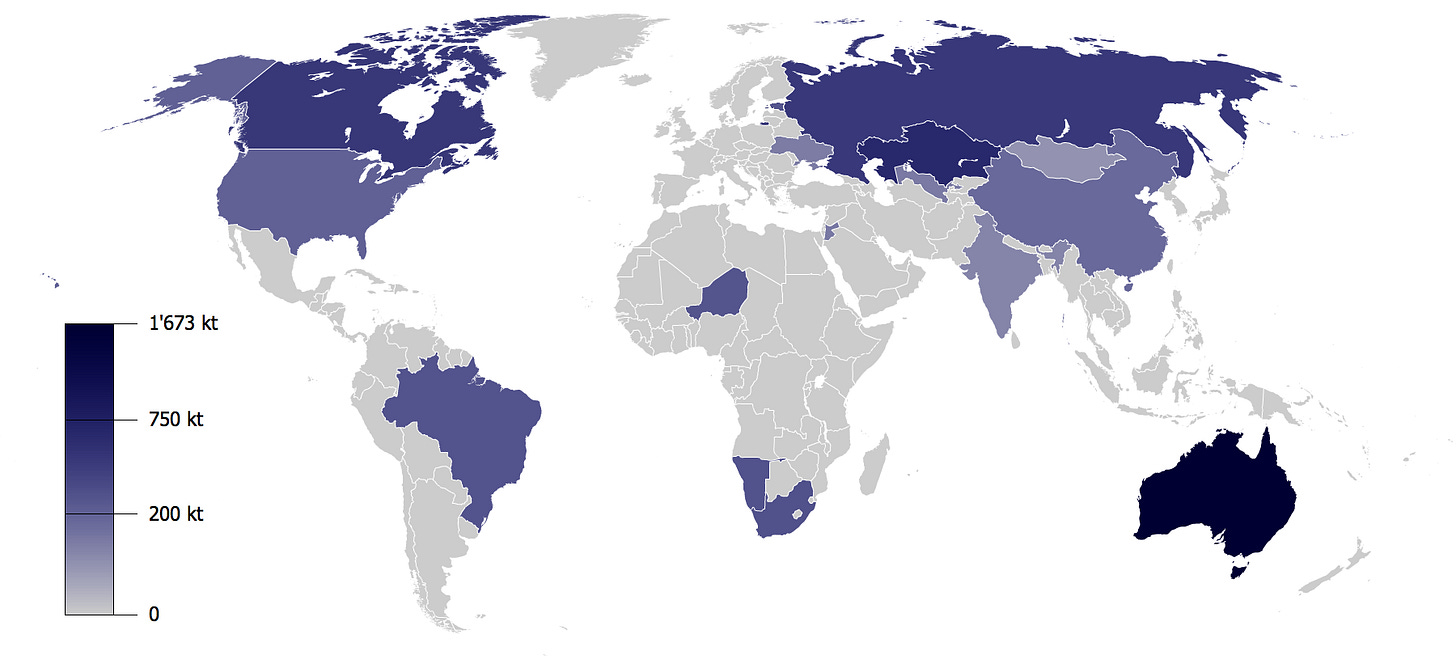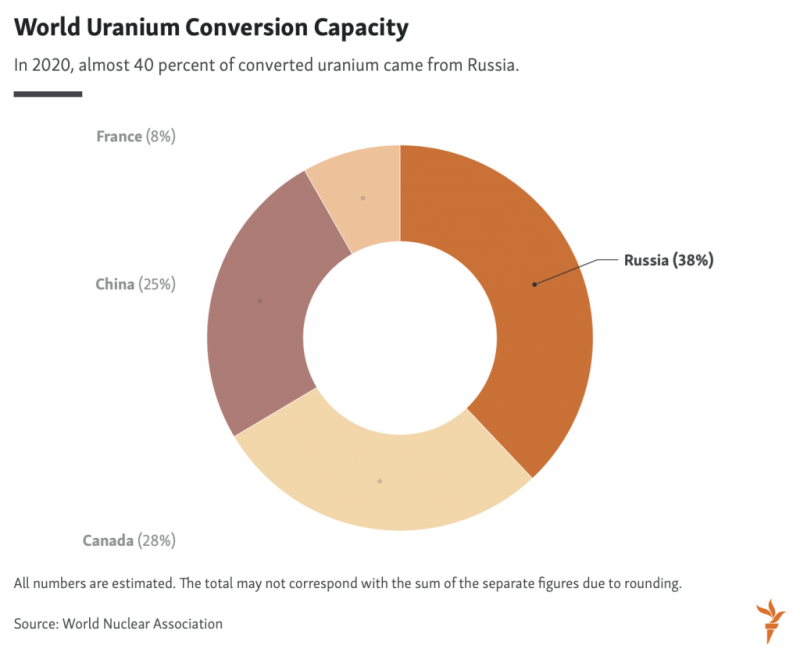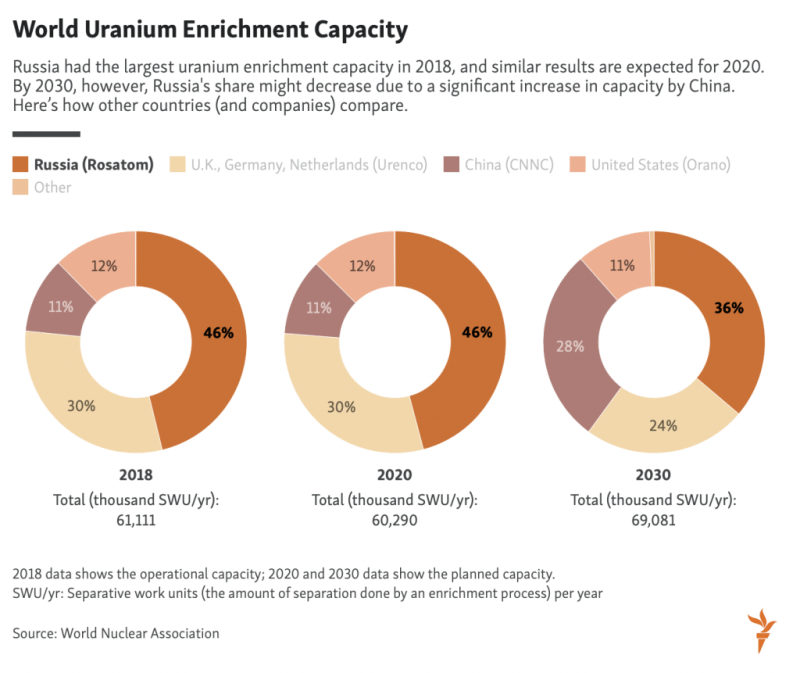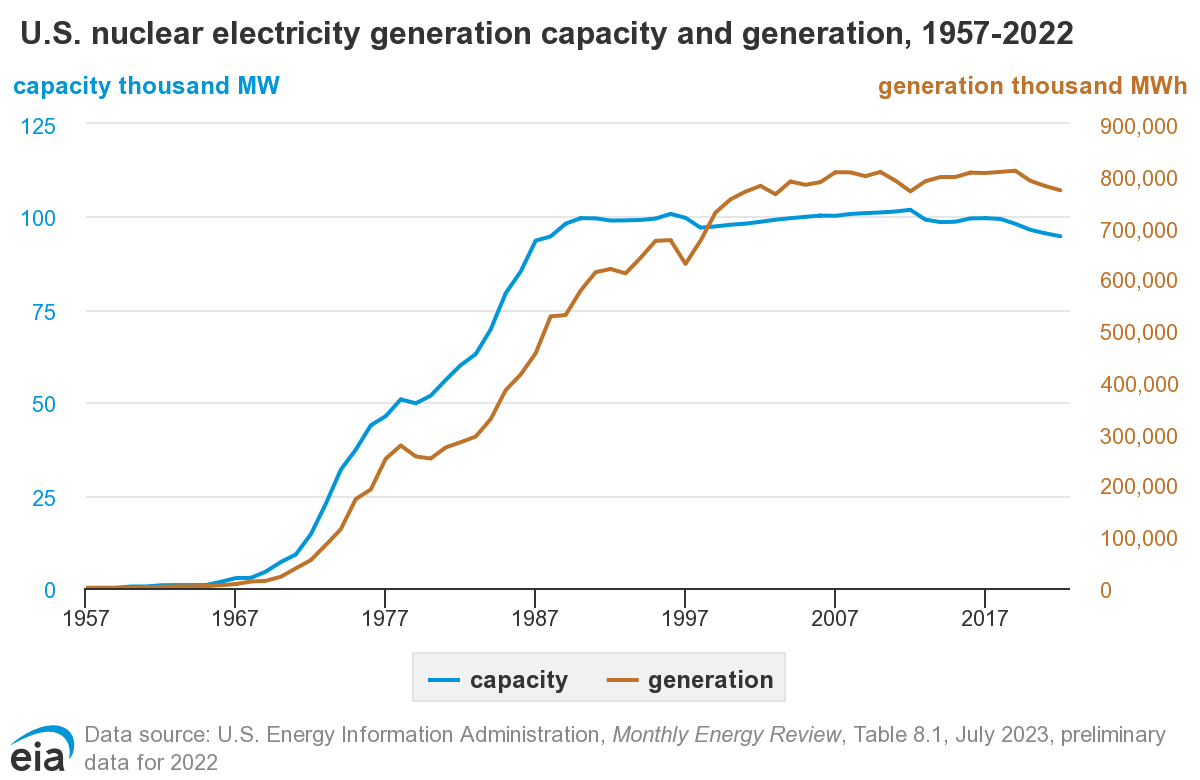The Haleu Effect
The turmoil in the energy markets the last couple of years has made societies more conscience of the energy that powers their societies. Where the energy comes from is just as important as the type of energy. The war in Ukraine has shown the world that over reliance on a single source for the majority of one’s energy is failure policy. No country has figured this out more than Germany, it’s over reliance on cheap Russian natural gas & the replacement of it’s nuclear fleet with intermittent wind & solar power has cause extensive damage to its economy, causing industry destruction & inflationary pressures for it's citizens. The whole EU has been grappling with surging energy cost which- while having come off it’s highs-shows no signs of relenting.
Many of the world leaders, thinkers, & politician have turned to nuclear claiming it to be a panacea for the world’s energy woes. On it’s surface it is mostly true. There is not a more dense form of energy any where on earth. It would not take much for a country to have a massive nuclear role out program and accomplish many of it’s energy, environmental, regional & labor initiatives. France, Sweden, Finland, and the Province of Ontario Canada are examples of such initiatives. As Doomberg likes to say—shouts out to the Green Chicken:
“If fission nuclear energy were discovered today it would be hail as an energy miracle” Doomberg The Power Hunrgy Podcast
As more attention is brought to the nuclear space the more I fear it will amount to nothing burger. It’s not a case of technology or even pollical will, but of an overlooked detail that escapes most energy novice.
Let’s dig—pun intended—under the surface to uncover what people are forgetting. Uranium is one of the most abundant element on earth and can be found almost anywhere on earth from rocks, soil, & river to oceans. People, animals, & organism consume it daily.
Uranium 2020: Resources, Production and Demand
As with most commodities what matters is not the quantity of supply but the quality or type of supply. You see uranium, just like crude oil, can not be use in it's natural state, it must be refined into a useful product. Natural uranium U-238 is not suitable as fuel. The overwhelming majority of the world 500 commercial operating nuclear reactors require uranium “enriched” at U-235 isotopes.
As of 2020, four conversion plants are in operation: in Canada, China, France, & Russia. Russia dominants with 38% of converted uranium infrastructure in the world followed by Canada at 28%, China at 25%, & France at 8%.
Enrichment Capacity is denominated again by Russian with 46%, (U.K, Germany, & Netherlands) at 30%, China at 11%, & United States with 12%. We see that Russia is a significant player in both uranium enrichment & services. And it is this closed loophole system that has given Russia a stranglehold on the nuclear industry with the same level of control Russia has on EU natural gas market.
One can see that Russia is a major supplier of uranium and enrichment services proving 20% of EU uranium and 14% of United States uranium. These number do not fully represents the significances of Russia influence on the market. If one were to included the satellite state of Kazakhstan then EU supply of uranium coming from Russia would be 39% and 53% for the United States, far more of precarious situation than first appears.
Another issue is with the nuclear renaissance is Russia’s leading position as an exporter of Nuclear plant development. Currently there are 11 countries—many of them NATO members—with Russia nuclear plant technology those countries are: Bulgaria, the Czech Republic, Hungary, and Finland with plants under construction or planned in Egypt, Turkey, and Argentina. These countries will need fuel and that fuel is only processed and exported by Russia. To further cement this issue, of the 19 reactor built between 2012-2021 by Russia’s state-owned Rosatom, 15 were aboard compare that to the South Korea with 4, China 2, and France 2. Russia’s scope is breath talking.
This relation with Russia and the rest of the world is not slowing down of the 195 recognized countries at least 50 have some nuclear cooperation with Russia, cementing Russia’s position in the nuclear power cycle.
So we are confronted with a few question: Will there be a nuclear renaissance? Will nuclear power save us from climate-change? Are there ways around Russia strategic nuclear power-cycle choke points in a time frame that matters? The answer is to all these question is NO. There is no national policy in places that matters that I have seen so far that leads me to believe nuclear energy will be a major piece of any countries plan to for energy security or climate policy. And while 60 power reactors are currently being constructed, only three of those countries— China, India, Pakistan, & Indonesia—have the population and economy size needed make a dent for nuclear plants. The rest of the countries with civilian nuclear programs already have the maximum amount of nuclear on their grid, compounded with the regulatory maze that comes with taking on big infrastructure projects in developed countries, it makes these major projects a non-starter.
The most interesting aspect of nuclear energy is in it’s capacity factor. In many ways the increase of capacity—uprating—can serve as a way to bring on another power plant without construction. In fact increased nuclear capacity in some countries is resulting from the uprating of existing plants. This is a highly cost-effective way of bringing on new capacity. Numerous power reactors in the USA, Switzerland, Spain, Finland, and Sweden, for example, have had their generating capacity increased.
In the USA, the Nuclear Regulatory Commission has approved about 165 uprates totalling over 7500 MWe since 1977, a few of them 'extended uprates' of up to 20%. The average capacity factor has risen from 50% in the early 1970s, to 70% in 1991, and it passed 90% in 2002, remaining at around this level since. To get an understanding of what these increase capaity means the E.I.A has a great summary:
The number of operating U.S. nuclear reactors peaked at 112, and their combined net summer electricity generation capacity was 99,624 megawatts. The number of operating reactors declined to 104 in 1998 and remained there through 2013. The number declined to 92 operating reactors in 2022. Total U.S. nuclear net summer electricity generation capacity peaked in 2012 at about 102,000 MW and declined to 94,765 MW in 2022. Although though the number of reactors has declined since 2012, power plant uprates—modifications to increase capacity—at individual nuclear power plants have made it possible for the entire operating nuclear reactor fleet to maintain high capacity-utilization rates (or capacity factors). These relatively high capacity factors helped nuclear power to provide 19%–20% of total annual U.S. electricity generation from 1990 through 2021. Some reactors also increased annual electricity generation by shortening the length of time reactors are offline for refueling.
This is happening in several countries:
Swizterland, had uprates increasing capacity by 13.4%. Spain added 810 MWe (11%) upgrading its nine reactors by 13%. Finland boosted the capacity of the original Olkiluoto plant by 29% to 1700 MWe. The Loviisa plant has been uprated by 90 MWe (18%). Sweden’s utilities have uprated three plants, the Ringhals plant by 305 MWe, Oskarshamn 3 21% to 1450 MWe, & Forsmark 2 120 MWe uprate (12%).
We see that nuclear energy can and has been used to add baseload energy to the grid at low cost without constructing any new facilities saving time and money. There is only one other infrastructure asset than has these characteristics, oil refineries. They are big, run 24/7, & have been able to ramup production despite not having a new one built since the 70s!
Will these workarounds help resolve the choke point problem? Keep in mind there is only one nuclear enrichment plant in the country that uses the most haleu. America got around this with the Megatons to Megawatts program.
Under this Agreement, the United States and Russia agreed to commercially implement a 20-year program to convert 500 metric tons of HEU (uranium-235 enriched to 90 percent) taken from Soviet-era warheads, into LEU (less than 5 percent uranium-235). The terms of the agreement required that it be implemented on commercial terms without government funds. The agreement named the Department of Energy as the executive agent for the US side.[4] The DOE appointed the newly privatized United States Enrichment Corporation (USEC) as the commercial agent, its executive program contractor. The Russian Federation designated Techsnabexport (TENEX), a commercial subsidiary of its Ministry for Atomic Energy (Minatom), as the agent to implement the program on commercial terms. On January 14, 1994, the commercial contract between USEC and TENEX (HEU-LEU Contract) was signed. The terms also required that the HEU be converted by dilution (downblending) to LEU in Russian nuclear facilities. USEC would then purchase the low-enriched fuel and transport it to its facilities in the US. The first shipment of LEU took place in May 1995.
The value of the process is in two components: the LEU Feed (feed component of natural uranium) and the work involved in the conversion process, measured as separative work units (SWU). Both have separate commercial values. Early disagreements on interpretations of the terms of the governmental and commercial agreements on this issue led to controversy and some delays. Although each shipment contains LEU, the commercial nature of the global uranium market defines the uranium and the enrichment components as separate commercial values and costs. The solution reached was for USEC to continue payments for the SWU component it purchased and also to transfer the equivalent of the LEU feed component to the Russian side. In March 1999, Minatom and the US Department of Energy signed the Agreement Concerning the Transfer of Source Material to the Russian Federation (the Transfer Agreement), and at the same time TENEX signed a Contract with a Group of Western Companies (Cameco, Canada; Cogema, France; Nukem, Germany/US) regarding the purchase of the LEU Feed. As years passed, numerous commercial contract terms were renegotiated and revised to accommodate mutual interests. Wikipedia
The process displaced some 8850 tonnes of uranium from mines each year, enough to meet 13%-19% of global needs. So utilities now have been drawing down their stock piles to meet demand. This in time will developed into another impediment in the nuclear renaissance.
In conclusion, unless the world invest in nuclear infrastructure or in nuclear plants that do not need enrichment, CANDUS, then the nuclear renaissance that people are talking about won’t happen. We will have another Nord Stream pipeline situation and we know what that brought.
Not to end on a sombre note, one could nativagate this by focusing on companies that are more service oriented to the nuclear industry or have the ability to remove pounds off the market. Small moducler Reactors (SMR), all the rage now, will be deployed for industrial— industrial steam production is response for 10% of global emission equal to aviation and passagner vehicle—and military applications. Keep in mind SMRs already exists and have been deployed in the United States since the 1950s, it's call a submarine, which could be deployed now, it's safety record is unmatched and it's cost has already been paid for by the taxpayers.







